Street Art Speaks: Cambodia’s First Female Street Artist Lisa Mam & NZ Artist Peap Tarr
Cambodia’s First Female Street Artist Lisa Mam and New Zealand Street Artist Peap Tarr.
A conversation about Cambodia, Street Art and Khmer Culture
When we arrived in Phnom Penh, we set out to find the best Street Art in the City. We soon learned about Lisa Mam, Cambodia’s first female Street Artist and her Partner in Street Art Peap Tarr, a New Zealand & Cambodian Graffiti and Street Artist. We arranged to do an interview with them in a local coffee shop.
This post contains Affiliate Links. We receive a small commission if you use our link. It doesn’t cost you any extra.
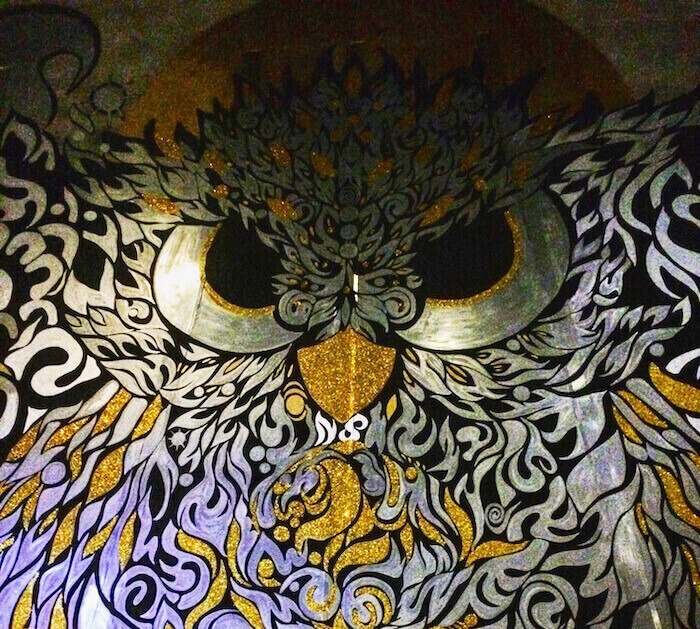
Lisa Mam, Cambodia’s First Woman Street Artist
Lisa Mam was Cambodia’s first Women Street Artist. She began painting street art in 2011 while in school. Lisa is now a practicing dentist, balancing street art and dentistry. She has shown her art and painted in Bangkok, France, New Zealand and elsewhere. Lisa is committed to helping a new urban art movement grown in Phnom Penh and Cambodia that showcases modern Khmer art.
Peap Tarr, New Zealand and Cambodia Street Artist
Peap Tarr is a New Zealand born street artist with Cambodian roots. He currently lives in Phnom Penh where he uses street art to explore his New Zealand and Cambodian heritage. Many of his earlier works are exclusively black and white. More recently, he has blended his Cambodia heritage into his art, infusing new colors and expression into his work. He has painted in Cambodia, New Zealand, Thailand, Hawaii and elsewhere.
Lisa and Peap often paint together. They sat down with us to talk about Street Art in Phnom Penh.
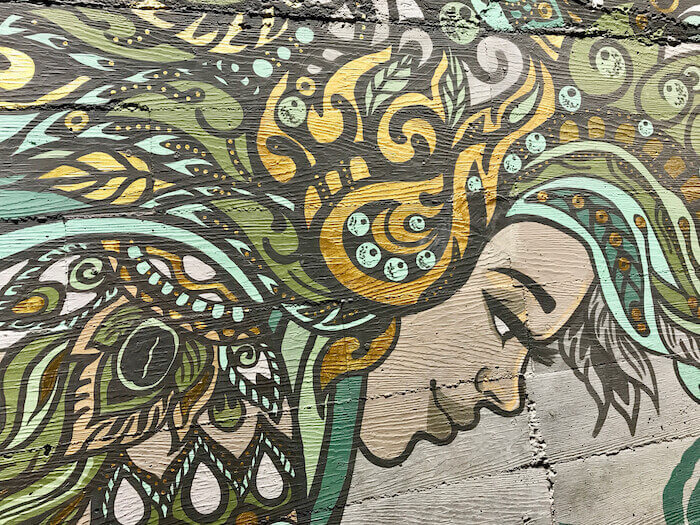
Can you Share Your Journey to Becoming a Female Street Artist?
Lisa
I wanted to be in the medical field like grandparents and father and at the same time, I liked painting. It runs in the family. My grandparents paint. My dad does drawing. My mom does drawing. My uncle paints. I like painting too.
In Cambodia, most people want you to make a career. Doctor, engineer. What they call a proper job. So, I pursued my study in Dentistry and graduated as a Doctor Dentist. But at the same time, I’m also drawing in my free time to get my mind off my studies because it’s so stressful. Lisa MamThen I got introduced to Peap and I saw his artwork on the wall. I thought it was pretty cool because he’s combining his Cambodian culture and his New Zealand culture. I had seen street art in Paris before but not in Cambodia.
We started painting together. Peap asked me to paint a wall. I thought it would be fun to paint on a big scale and not just on a regular piece of paper.
Peap
She was naturally good at it. To paint on a paper and canvas is one thing, but to be able to put that into proper proportion on a wall is different. She could naturally do it.
Lisa
I think 10 years ago, I might be the only Cambodia female street artist but now there are younger female artists painting. I cannot say I am the only one now.
When I say I am the first at doing things, it makes me sounds like a bit grand. I don’t want to say it. I want other people to see it for themselves and just describe it.
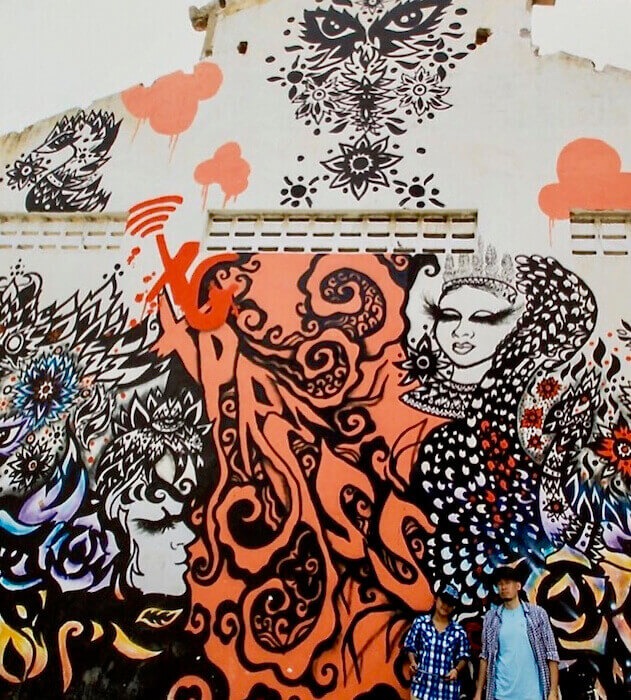
How Did You Become a Street and Graffiti Artist?
Peap
I started as a teenager. I was born in New Zealand but also lived in Sydney. Sydney in 1990s had a lot of graffiti. Graffiti from the States spread everywhere in the world. The influence from NY caught onto the youth everywhere. Graffiti culture. Hip Hop culture. Especially to minority youth around the world. It’s something they relate to.
That’s how I got into it. My friends did it. I did it. And it wasn’t something I took seriously. I was trying to do graffiti letters and stuff like that. Then I tried something from my heritage. My New Zealand side, my Cambodian side and combined that. So that’s where it took off because people saw the work on the street. Then I was contacted by a gallery, then my work got into a gallery and sold. Peap TarrThe person who bought it had a coffee shop in Auckland. She got me to put my work in there. I wasn’t really into painting on canvas, but I did it because of the show and because she asked me too. And then it sold. I thought this is pretty good so I kept painting. And I kept painting on the street with my friends.
Then I came back to Cambodia. I met Lisa. And we started painting together. Together we got a lot of attention. And, Lisa got a lot of attention. She was one of the only, the first Cambodian female street artist. So that got attention overseas in Thailand, in France.
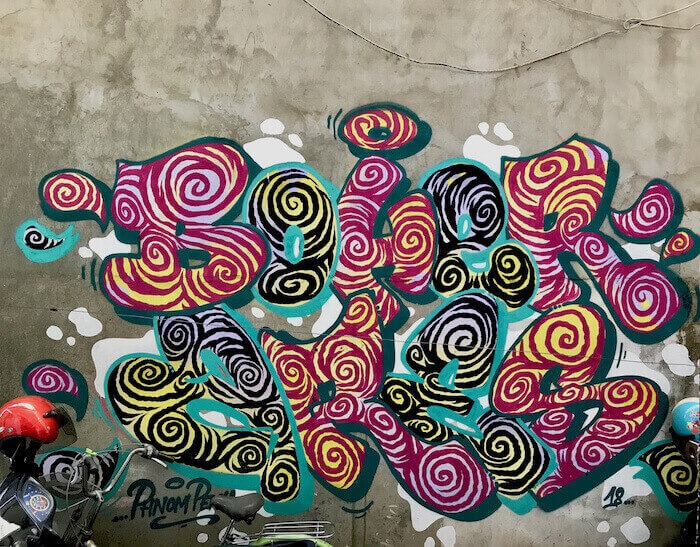
Can You Speak About Female Street Artists in Phnom Penh?
Lisa
It is different to be a woman street artist. There’s been a lot of people who give their opinion. They thought that a girl could not do this. That I was not Cambodian. A lot of foreign female artists come in to paint. They think the foreign female has more freedom, independence to do things outside on the street.
I feel that art is for everybody, it’s not just for men. And street art is a form of art. Just because there are a lot of guys doing graffiti. It’s like go outside, paint, tag with your spray can. It’s kind of “male.” That’s the image that they create. Lisa MamWhen people here see me as a female graffiti artist, they think I’m not from here. So, there are a lot of people that have their opinions. Because it’s very conservative here. You grow up in the family. Help the family. Go study. Get married. Have family. A lot of stereotypes.
But now it is better. Girls have more freedom to do what they want. They can express how they want to live. What lifestyle or life path they want to go or follow.
When I started doing it, it encouraged a lot of young girls that want to do it too. They can see that it’s okay to do things like this. It’s ok to do art even if your family is saying that it’s not a proper job, that it’s not something you should pursue in life.
As a matter of fact, everyone needs art. It’s more like a way to express the culture, idea and thought of a person. I think I started to do it and more people doing it. I’m not saying they would follow, more like they were encouraged.But I know it’s not just me that encouraging them. It’s from other sources. The internet. People google search and get inspiration. And, then they pick up the pencil and draw. There are many ways that encourage people to do art.
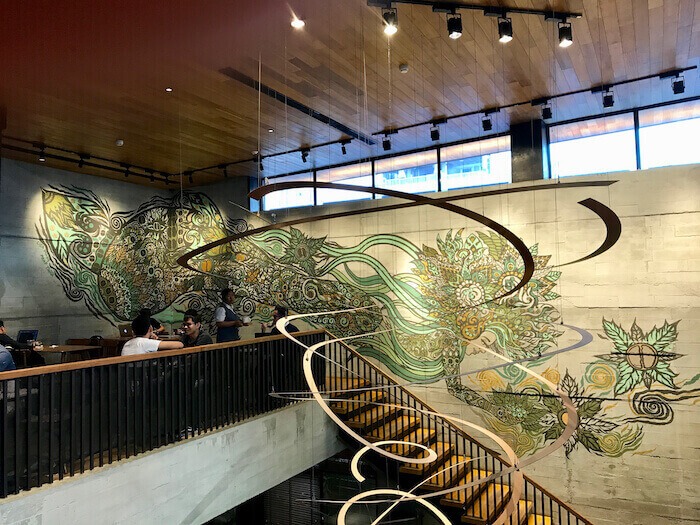
What Does Your Family Think About You Being a Street Artist?
Lisa
My dad was concerned when I was in school and doing it. My mom was easy going as long as I completed college. I also think my education was very important. And I didn’t want to drop out of college. I just wanted to continue to do what I loved to do. But my dad, worried that the painting distracted me from studying.
I graduated 4 years ago. Now, I am a Dr. Dentist and street artist.
I have more freedom now than when I was studying. Then, I had to paint on the weekend. But now I can just make appointments with clients. When I want to paint, I can just go paint.
How Do Young People Talk About the Khmer Rouge and the Genocide?
Lisa
My grandparents were working closely with the former king of Cambodia and also doctors. They were killed by the Khmer Rouge. My dad was separated from his brother. His brother went to Paris but my dad was here. My mom and her whole family were here.
Young people remember. They know. They acknowledge everything through the films, history books, everything. But mostly we don’t really have conversations about it, day to day, hanging out at the coffee shop or in the classroom. Because it’s a very tragic time.
I don’t want Cambodia to be only known for the Khmer Rouge and the genocide. I want Cambodia to have a newer face. We’re developing. A beautiful country. We have our culture. A lot of great things. I and the young people would like to focus on the positive side. And try to create something that will make a good name for Cambodia. Lisa Mam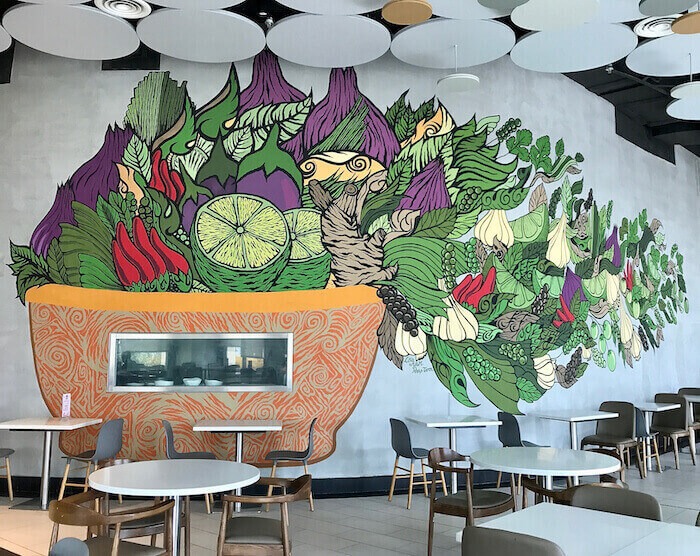
Can you Talk about the Khmer Influence on Your Art?
Lisa
I mostly use all the ornaments, the patterns of Cambodia but I make it more modern. I don’t do traditional arts. A lot of people come at me asking why do I have to do modern art. It’s something that they don’t see as “Cambodian.”
I feel that there is a lot of traditional art being done already. I don’t disrespect the traditional art. It’s beautiful. Artists that do traditional are very talented. They’re great artists.
At the same time, I want to translate it into something new because I want it to be modern looking but still Cambodian. It’s part of expressing about how I want things to look in my perspective. You don’t forget the tradition but also appreciate the modernity of what is coming for you and the good concept it gives in your head. Then you translate it into the artwork.
How do you Bring Together Hip Hop, New Zealand and Cambodia in your Urban Art?
Peap Tarr
I grew up around a lot of graffiti culture, hip hop culture. That’s the experience of youth in the world. African American, Puerto Rican, especially in NY. That’s what we would see. I would think of ways to relate it to me as well.
For me, I like graffiti but I don’t want to be imitating what other people are doing. I love the concept and what’s coming from the States. And, what I see in other countries too. But I wanted to do something that represented me. Peap TarrThat’s when I started to explore more with my heritage. People never know where I am from. New Zealand is a very mixed society already. And, you always get mistaken for all sorts of things. I felt like in my art that I could talk about my identity. Identity is important to people. It’s who you are and that was a way of me visually talking about it. Talking about my New Zealand heritage, my Cambodian heritage and would open up dialogue or conversation with people.
I like the aesthetics of what we have in New Zealand, especially Maori culture, indigenous culture and Polynesian culture. Because a lot of people from the islands—Samoa, Tonga, Fiji—live in New Zealand. We have the biggest population of Pacific Islanders in the world beside Hawaii.
At the same time, I wanted to relate to my Cambodia side as well. And I wanted to modernize things. Kind of like Lisa. I think that’s why we jelled so well together. Because we want to do the same thing with our heritage. For me, there’s a little twist with New Zealand.
Originally, that’s how I started using a lot of black and white colors. New Zealand has a lot of black and white. So there’s that aspect as well. Being Cambodian, I started to play more with colors. It’s actually a very colorful environment. Even the temples. A lot of gold, silver, greens, oranges, yellows, reds.
Painting with Lisa—we started incorporating more and more colors. Even then we have black and white and silver. The one that I helped Lisa with, the Number 8 Bar. That was all black and silver. That’s pretty cool. We were playing around with the lighting. It’s a bar and when the lights hit the painting, it illuminates silver and gold.
Can You Talk About Gentrification, Graffiti and Street art?
Peap
The area we paint behind the French mission. That building was an orphanage. Lisa and I painted it with Seth, a French street artist. He was doing a TV documentary and he wanted to paint with us. That place had nothing there. There was no street art there. As soon as people saw it, people started painting there. People came over from France. The whole place is filled with art. But there was nothing there in 2013 when we painted that mural.
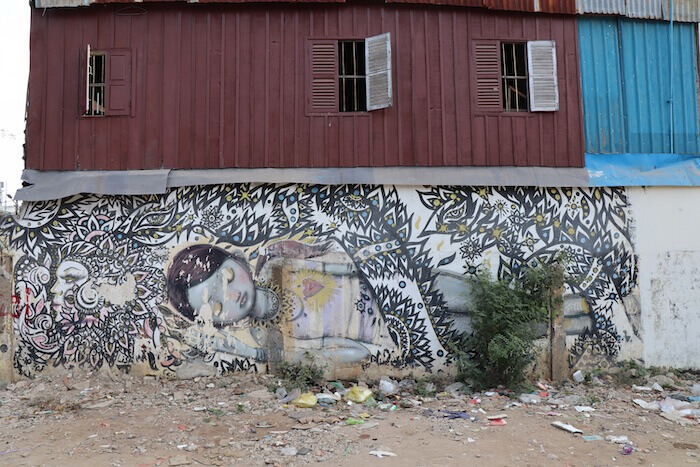
It’s going to disappear. They are developing an area nearby it. Eventually, it is going to be gone. A lot of places that we painted on the street early on are now high rise buildings. If you came across the bridge, you would have seen some buildings, that’s where we used to paint. It was factories. No one used them. It was an abandoned place. Now it’s become high rise buildings. And that’s what’s happening to all of Phnom Penh. It’s like natural, development.
From what I see in Cambodia, these places are already going to be built. It’s already in the plan. No one goes there. But some places people squat and have already been assigned to be built. It’s not like street art caused it. There wasn’t anything there. Then it got media attention outside. I don’t think the government here even pays attention to street art.
Lisa
In order to do Cambodian Street Art, you have to ask building owners for permission and show them the artwork that you are going to do. You only have to get permission from the government if you are going to do something big scale by the government buildings. Where people see it. Or if you do something connected to politics. Then you have to get permission.
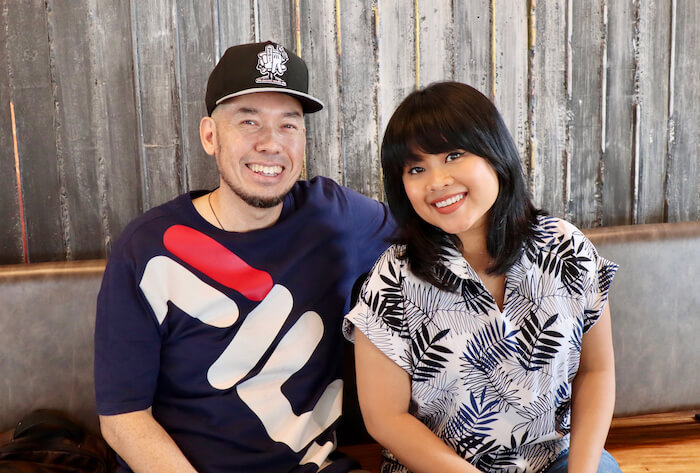
What Would You Like to Say About Cambodia?
Lisa
Definitely see the art, the street art. The modern side of the art and also the traditional art. And also explore the nature scene. In Cambodia there are a lot of things to do if you go to the provinces. There are different things in each province. It’s a nice place, a good pleasant place. Come here. Walk around enjoy your day, the people, the food. And the culture.
Peap
In Cambodia street art is starting to evolve just like other places in the world. I am hoping that the people of Cambodia, the youth here start to develop their own style. And technique and their own way of doing it. That’s something that I look forward to seeing. And I think it’s going to happen.
Lisa really kicked it off and both of us got it to where it is now along with some other artists. Time will tell as it grows and evolves. The rest of Asia has a lot going on. Thailand, Malaysia, Singapore, Indonesia, Japan, China and Hong Kong. Even Vietnam. But Cambodia was not really there yet. That’s the great thing with graffiti art and street art. It is a worldwide community.
If you want to see Street Art in Phnom Penh, our post on Cambodia Street Art gives more details on where to find it.
We’d Love to Hear Your Thoughts on this Post. Have You Spoken to Street Artists? Anything You Want to Say to Lisa and Peap?
Please Pin and Share
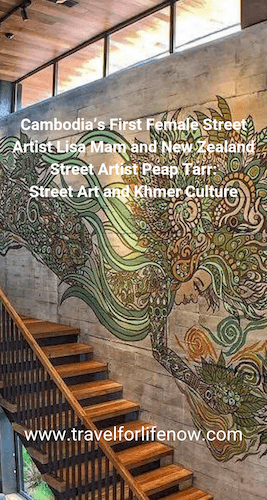
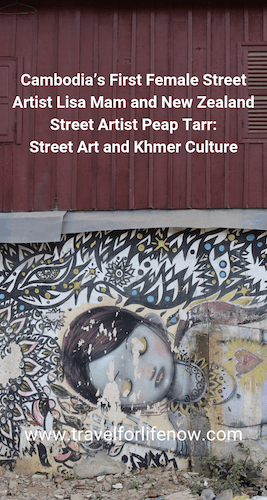
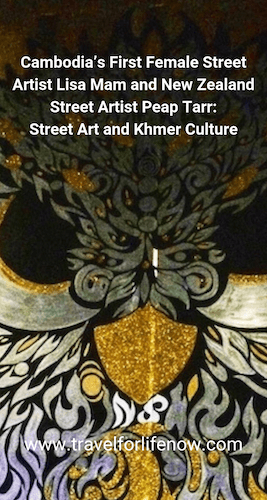

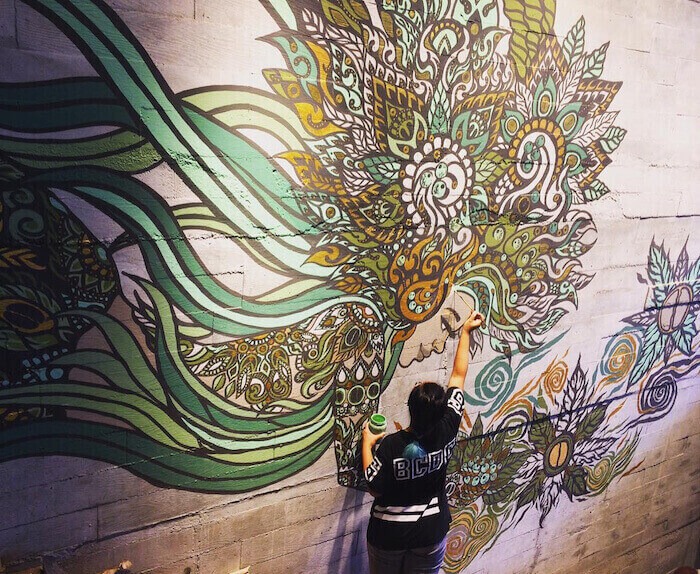
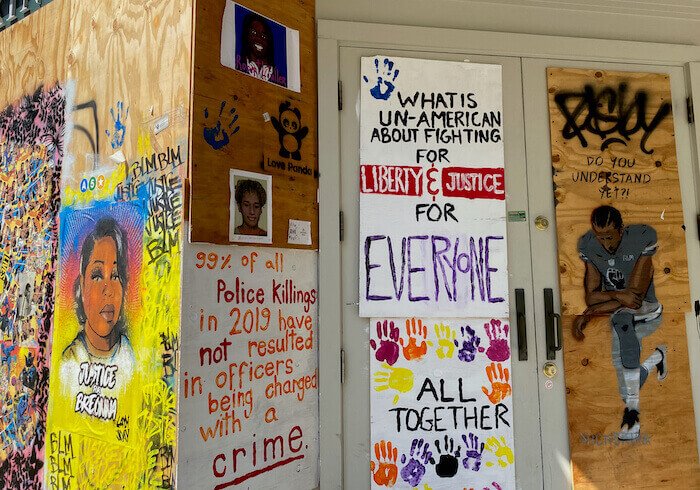
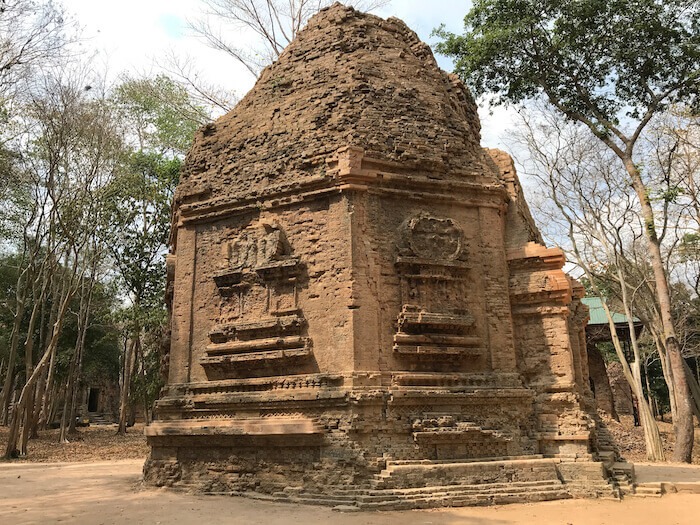
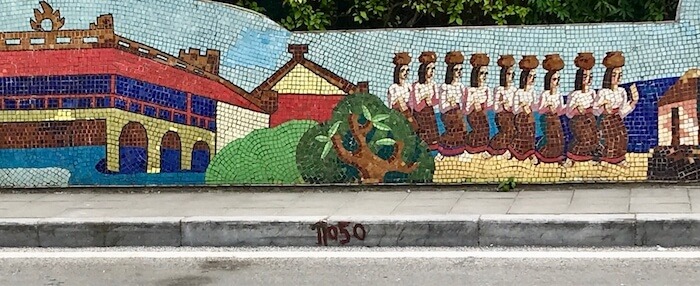
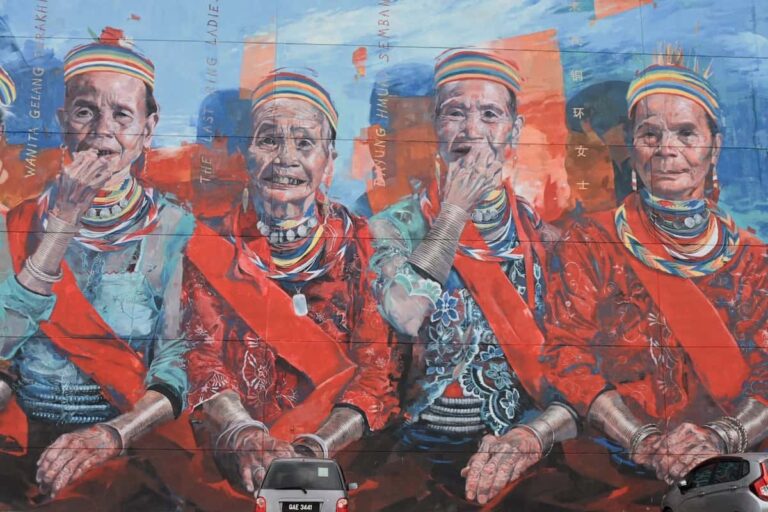
I love this post!! You are so lucky to have met and spent time with them. So beautiful and inspiring!!
Great post, it’s wonderful that you’ve spoken with Lisa and Peap and are showcasing their voices and art. It’s always educational to hear from residents and artists and I especially love hearing from women. We loved Cambodia and learning from Khmer people too. There is so much to learn and it’s important to know the past as well as where they’re headed in the future.
Emma,
Thanks for your comments. And, glad you found the conversation with Lisa and Peap interesting. And, I agree, we need to hear more from women street artists.
Sue
I love street art! So much talent! That Starbucks mural is gorgeous.
Kit,
I love the Starbucks mural, too. Lisa and Peap are very talented.
Sue
What a fabulous angle you have taken Sue. Love the interview approach, it’s made it so much more personal. kx
Karen,
Thanks for your comments. Street Art’s voice is on the walls and the streets. And, I love to engage artists in a dialogue about how they think about art and culture.
Sue
There’s something deeply pre-colonial Asian in Lisa’s attitude. It’s a unifying, merging outlook to life, that you don’t have to ‘choose’ between medicine and art, you don’t have to choose between modern and traditional art. A genesis attitude which we once had before the region became colonised and its people lost cultural autonomy, and which we ourselves have now forgotten, was not about picking one side and denying another, nor even about picking two sides – but that there are more sides than two, and about the mixing and evolution of many facets of civilised society through your life. I’m happy to see examples of young Asians who might restore to our region the real essence of the Asian worldview.
Teja,
Thank you for your comments. I think there is much lost by the European notion of duality and the need to pick one side or another. There is much to learn from Lisa and Peap and their efforts to cross boundaries and, indeed, create a perspective that is both/neither traditional/new. There are more “sides” than 2 as you say and I’d like to see us embrace that more.
Sue
I love this article. I am fascinated with mural art and the artists themselves. I appreciate the interview style of the article and the opportunity to get to know these 2 talented people.
Janet,
Thanks for your comments. Glad you loved it and got to know Lisa and Peap. They are very interesting artists.
Sue
Really interesting article & a great opportunity you had to sit down with them & share their story. Thank you!
I love reading about successful women in Cambodia! I’ve spent a lot of time there and am well aware of the challenges they face. The artwork is spectacular! I love street art and would never have expected it there.
Kristina,
Thanks for your comments. Women in Cambodia do face a lot of challenges. Street art is growing in Cambodia and I think over the next few years the scene will develop even more.
Sue
Thanks for sharing this. I saw Lisa and Peap work in Cambodia last year, so interesting to be able to learn more about them and their work. Loved reading it!
Thanks, Paula. Peap and Lisa are very interesting to talk to. We didn’t get a chance to see them work. Maybe in the future.
Sue
Love this! I love street art and think that cities that embrace it are so much more vibrant. I really enjoyed the interview. Thank you!
This is a wonderful reason for me to make another trip to Phnom Penh!
A very inspirational interview with female street artists. It would be really amazing if we can support our fellow women on their journey.